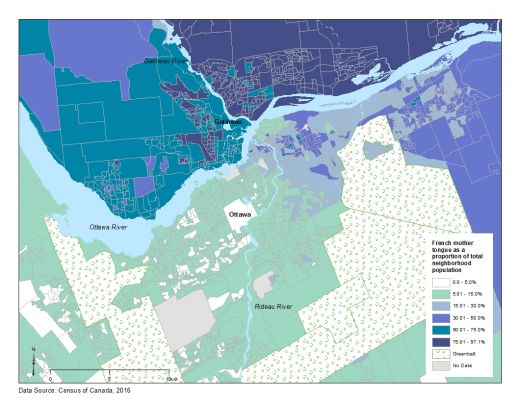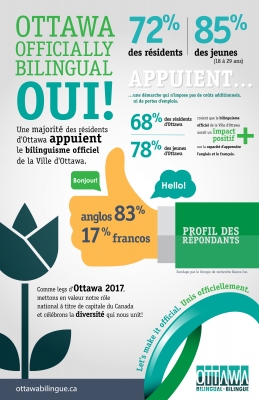The public service is only one of the many facets of Ottawa’s prosperous economy that draws Francophones from all over the country. Numerous immigrants also settle in the capital, renowned for its excellent colleges and universities. The population reporting French as first language rises from 104,120 in 1981 to 131,299 in 2011. This critical mass enables the development of a French institutional network operating in many sectors of collective life. New institutions include, for example, a Francophone college, a Francophone professional theatre centre (La Nouvelle Scène), and a university hospital, to name just a few.
During the same period, however, the percentage of Ottawa Francophones drops from 19.2% to 15.0%, their growth surpassed by that of the non-Francophone population. Analysts are concerned about the long-term effects of the rapid growth of bilingual families, and the limited transmission of French language to the next generation. The Anglicization of Francophones, due to the difficulty of integrating French in the workplace and in the public arena in general, is an equally serious challenge.
Whether or not they use English on a daily basis, Ottawa Francophones are proud of their culture, and their membership in the community cannot be denied. The numerous French schools in the region are important channels for transmitting a strong cultural identity among youth populations. Attendance begins at a very young age, with child-care services often offered in the schools. Places like the Centre des services communautaires Vanier, the Patro in Lowertown and the Centre culturel d’Orléans, operated by the Mouvement d’implication francophone d’Orléans (MIFO), serve as gathering places for French-speaking families and seniors in those well-established Francophone neighbourhoods in the east and centre of the capital region.
Today, the highest proportions of Francophones are still found in these traditional neighbourhoods. But French areas also extend to the south and west, covering the city’s entire territory. High value is placed on founding new French institutions in these parts of the city – for example, establishing the Maison de la francophonie d’Ottawa, where multiple French organizations would be housed under one roof, in a part of the city that has seen Francophone numbers soar in recent years. But that project was delayed, with costs exceeding all projections.
Here, as in other new French-language areas in Ottawa, access to French services remains uneven. Unlike Government of Ontario services, available in both languages under the 1986 French Language Services Act, the City of Ottawa does not guarantee French service by law. Despite support for bilingualism from a majority of Ottawa citizens, the capital city of Canada is still not officially bilingual 150 years after Confederation.
The façade of the “La Nouvelle Scène” theatre, located at 333 King Edward Avenue in Ottawa, November 28, 2009. This building was demolished to make way for a new “Nouvelle Scène” in 2016, located at the same address. Photo: Syl.sab.
Source : CC BY-SA 3.0. Wikimedia Commons, LaNouvelleScene_Ottawa.


